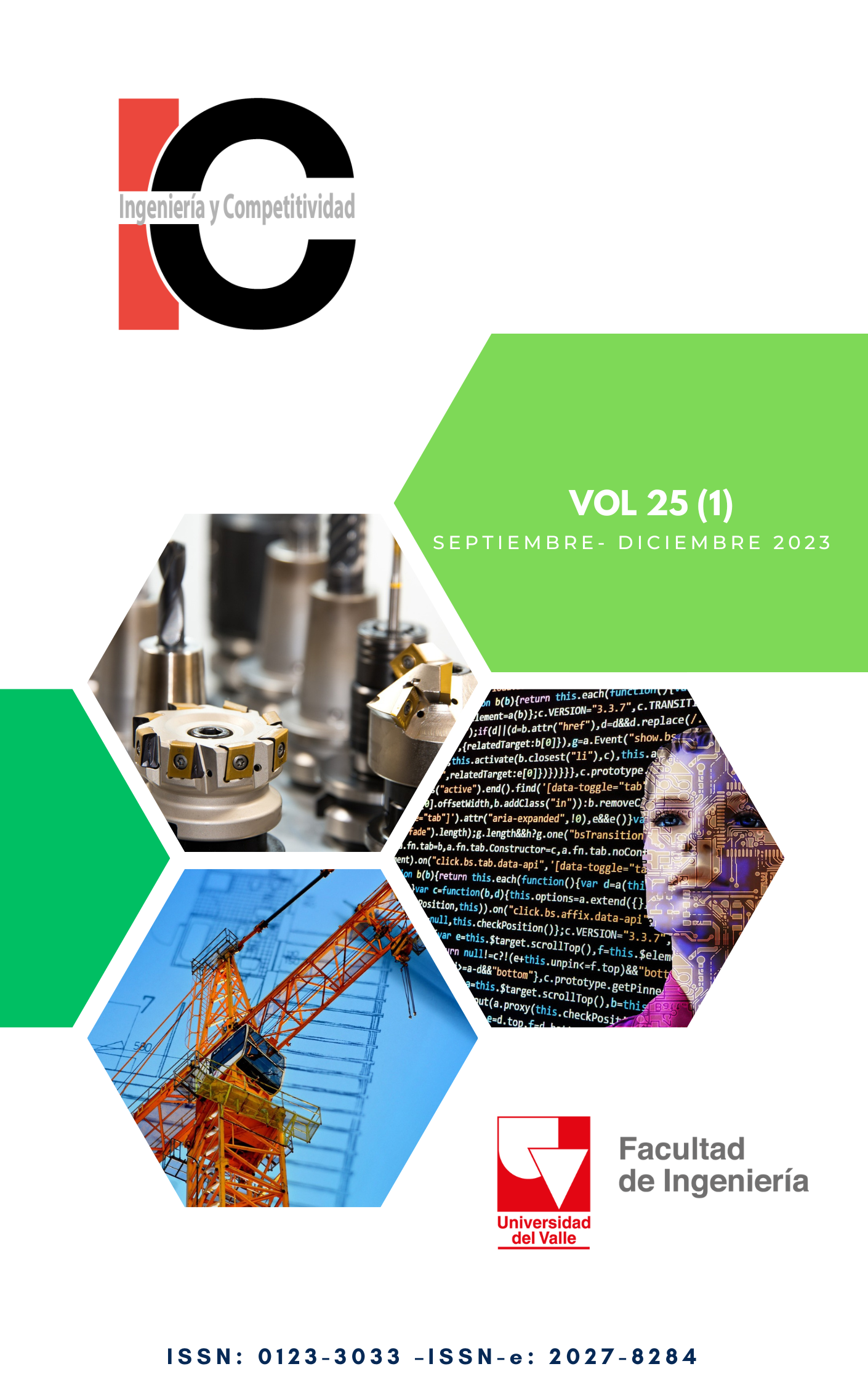Fortalecimiento de canales de comunicación para personas con discapacidad fono-auditiva en ambientes de educación básica mediante captura de movimientos usando lenguajes de señas
Palabras clave:
Ambiente educativo, Inteligencia artificial, Lenguaje de señas colombiana (LSC), Modelo de aprendizaje deductivo, Reconocimiento de imágenesContenido principal del artículo
Se presenta la implementación de un modelo deductivo dirigido al reconocimiento de vocabulario basado en los gestos de Lenguaje de Señas Colombiano (LSC) que enfoca una solución a la falta de conocimiento y acompañamiento en su aprendizaje en personas que están continuamente relacionadas con esta población que presentan discapacidad fono-auditiva. Estos gestos con las manos son utilizados debido a su gran nivel de expresividad y siendo la principal fuente de comunicación para personas con este tipo de discapacidad.
Dentro del reconocimiento de patrones/gestos de movimiento en LSC, es necesario percibir y reconocer la ubicación, orientación, lugar de articulación y punto de contacto de las manos. Conociendo acerca de las tecnologías y las investigaciones sobre algoritmos de reconocimiento gestual, análisis de patrones y redes neuronales que ayudaron a la selección correcta del modelo deductivo implementado.
De tal manera que la implementación del modelo de reconocimiento de imágenes permitió analizar fotogramas y/o imágenes reales. Analizando la información importante y resolviendo problemas específicos. Estas características se encuentran enfocadas dentro de esta investigación, logrando acompañar a la población en ambientes educativos, mediante la detección de objetos en una imagen en tiempo real usando parte de la inteligencia artificial expuesta en el modelo deductivo.
Muñoz I, Ruiz M, Darbet C, Lago E, Fernández E. Comunidades sordas: ¿pacientes o ciudadanas?Deaf communities: patients or citizens? ScienceDirect [Internet]. 2011;25(1):72–8. Available from: https://doi.org/10.1016/j.gaceta.2010.09.020
Espectador E. Inclusión en la educación: estudiantes sordos en Colombia. In: Espectador E, editor. Maleducados. Bogota, Colombia; 2021.
González C, Yimes F. Sistema de reconocimiento gestual de lengua de señas Chilena mediante cámara digital [Internet]. PONTIFICIA UNIVERSIDAD CATÓLICA DE VALPARAÍSO; 2016. Available from: http://opac.pucv.cl/pucv_txt/txt-0500/UCC0990_01.pdf
Pichuho J, Constante P, Gordón A, Mendoza D. Interpretación de lenguaje de señas ecuatoriano empleando visión por computador. Ibérica Sist e Tecnol Inf [Internet]. 2019;(960–971):13. Available from: https://www.proquest.com/openview/84337a90042da817ad3453747249970a/1?pq-origsite=gscholar&cbl=1006393
Guerrero J. Algoritmos de procesamiento de imágenes y redes neuronales artificiales para el reconocimiento de la lengua de señs colombiana (LSC). Rev Colomb Tecnol Av [Internet]. 2016;2(28):1–8. Available from: https://www.unipamplona.edu.co/unipamplona/portalIG/home_40/recursos/05_v25_30/revista_28/20052017/01.pdf
Muñoz Y, Moreno L. Implementación de un algoritmo para a clasifiación automática de leguaje de señas colombiano en video usando aprendizaje profundo [Internet]. Universidad Catóica de Colombia; 2020. Available from: https://repository.ucatolica.edu.co/bitstream/10983/24980/1/Proyecto de grado.pdf
Alvarez P, Castro G. Modelo de red neuronal convolucional para el reconocimiento del alfabeto en lenguaje de señas colombiano [Internet]. Universidad del Sinú; 2019. Available from: http://repositorio.unisinucartagena.edu.co:8080/xmlui/handle/123456789/56
Barragán E, Lozano S. Identificación temprana de trastornos del lenguaje Early identification of language disorders. ScienceDirect [Internet]. 2011;22:227–32. Available from: https://www.sciencedirect.com/science/article/pii/S0716864011704175?via%3Dihub
Tzuta L. LabelImg [Internet]. Github. 2020. Available from: https://github.com/tzutalin/labelImg#labelimg
Nabende J, Tusubira J, Babirye C, Nsumba S, Omongo Christopher. A dataset of cassava whitefly count images. ScienceDirect [Internet]. 2022;41. Available from: https://www.sciencedirect.com/science/article/pii/S2352340922001238#cit_1
Everingham M, Eslami A, Gool L, Williams C, Winn J, Zisserman A. The PASCAL Visual Object Classes Challenge: A Retrospective. Int J Comput Vis Vol [Internet]. 2015;111:98–136. Available from: https://link.springer.com/article/10.1007/s11263-014-0733-5
Martinez E, Morillas F. Deep Learning Techniques for Spanish Sign Language Interpretation. Hindawi [Internet]. 2021;2021:10. Available from: https://doi.org/10.1155/2021/5532580
Brownlee J. How Do Convolutional Layers Work in Deep Learning Neural Networks? [Internet]. Machine Learning Mastery. 2019. Available from: https://machinelearningmastery.com/deep-learning-for-computer-vision/
Adeyanju I, Bello O, Adegboye M. Machine learning methods for sign language recognition: A critical review and analysis. Intell Syst with Appl [Internet]. 2021; Available from: https://doi.org/10.1016/j.iswa.2021.200056
Liang T, Bao H, Pan W, Pan F. Traffic Sign Detection via Improved Sparse R-CNN for Autonomous Vehicles. Hindawi [Internet]. 2022;2022:16. Available from: https://doi.org/10.1155/2022/3825532
Farfán O, Camargo J. Modelo computacional para reconocimiento de lenguaje de señas en un contexto colombiano. TecnoLógias [Internet]. 2020;23(48):197–232. Available from: https://revistas.itm.edu.co/index.php/tecnologicas/article/view/1585/1637
Tensorflow. TensorFlow JS [Internet]. npm. 2022. Available from: https://www.npmjs.com/package/@tensorflow/tfjs
Anirudh R. Convolutional Neural Network Tutorial (CNN) – Developing An Image Classifier In Python Using TensorFlow. edureka [Internet]. 2020;7. Available from: https://www.edureka.co/blog/convolutional-neural-network/
Lu, Jiaqi Liu, Ruiqing Yuejuan, Zhang Zhang, Xiaxiang Zheng, Longbo Zhang, Chao Zhang, Kaiming Li, Shuan Lu Y. Research on the development and application of a detection platform for colorectal cancer tumor sprouting pathological characteristics based on artificial intelligence. ScienceDirect [Internet]. 221AD;6. Available from: https://doi.org/10.1016/j.imed.2021.08.003
Cabrera J, Cervantes J, Lamont G, Ruiz J, Jalili L. Mexican sign language segmentation using color based neuronal networks to detect the individual skin color. Expert Syst Appl [Internet]. 2021; Available from: https://doi.org/10.1016/j.eswa.2021.115295
Wei X, Chen X, Lai C, Zhu Y, Yang H, Du Y. Automatic Liver Segmentation in CT Images with Enhanced GAN and Mask Region-Based CNN Architectures. Hindawi [Internet]. 2021;2021:11. Available from: https://doi.org/10.1155/2021/9956983
Guo X, Liu S. A Scatter Search Approach for Multiobjective Selective Disassembly Sequence Problem. Hindawi [Internet]. 2014;9. Available from: https://doi.org/10.1155/2014/756891
Programmer Click. SSD para detección de objetos en tiempo real [Internet]. 2020. Available from: https://programmerclick.com/article/91891967042/
Cloud I. IBM Cloud Object Storage [Internet]. IBM. 2022. Available from: https://www.ibm.com/co-es/cloud/object-storage
Vayghan L, Saied M, Toeroe M, Ferhat K. A Kubernetes controller for managing the availability of elastic microservice based stateful applications. J Syst Softw [Internet]. 2021; Available from: https://doi.org/10.1016/j.jss.2021.110924
Kubernetes. ¿Qué es Kubernetes? [Internet]. Documentación distribuida Kubernetes. 2022. Available from: https://kubernetes.io/es/docs/concepts/overview/what-is-kubernetes/
Downloads

Esta obra está bajo una licencia internacional Creative Commons Atribución-NoComercial-CompartirIgual 4.0.
Los autores que publican en esta revista están de acuerdo con los siguientes términos:
Los autores ceden los derechos patrimoniales a la revista y a la Universidad del Valle sobre los manuscritos aceptados, pero podrán hacer los reusos que consideren pertinentes por motivos profesionales, educativos, académicos o científicos, de acuerdo con los términos de la licencia que otorga la revista a todos sus artículos.
Los artículos serán publicados bajo la licencia Creative Commons 4.0 BY-NC-SA (de atribución, no comercial, sin obras derivadas).

